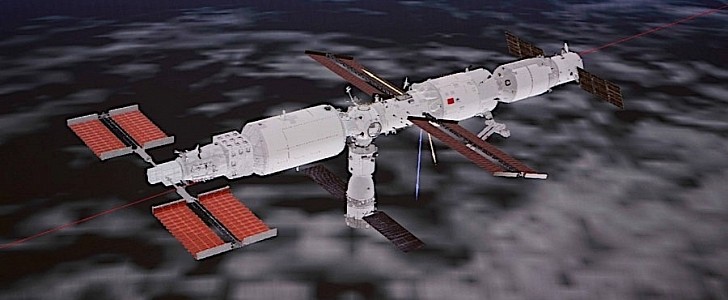It’s not long now until the International Space Station has some companions up there in orbit capable of matching it in many aspects. The most advanced of these companions is presently the Chinese National Space Administration's (CNSA) Tiangong, currently in the process of being assembled beyond the atmosphere of our planet.
When work on it is completed, the Chinese station will look something like the official rendering we used as the main photo of this piece: a long assembly comprised of modules attached end-to-end, with solar panels deployed in several locations, and docking ports here and there.
Right now, if you could find some way to see it up there, the station is shaped like an L. That’s because at the end of last week, Chinese taikonauts on board the Tiangong and ground controllers moved one of the station’s lab modules, the Wentian, from the axial port of the Tianhe core module to a radial port of the same piece of real estate.
Launched back in July, Wentian is described by the CNSA as the “largest and heaviest spacecraft China has ever built,” but also “the world's heaviest self-propelled spaceship in service” – it weighs (here on Earth, of course) 23 tons, and is almost 18 meters (59 feet) long.
The lab holds eight scientific stations and will be used to “serve biological and life science studies,” including research on the in-space growth, aging and genetic traits of plants, animals and microbes. No less than 22 extravehicular payload adapters are fitted to allow for the expansion of the lab’s research scopes.
As for the Tiangong, the station should be fully operational in the near future. By the end of the year, the Asian nation will launch another lab module, called Mengtian. At the moment, the station comprises the Tianhe core module, the Wentian lab, the Shenzhou XIV spacecraft, and the Tianzhou 4 cargo ship.
Floating around at altitudes of up to 280 miles (450 km), the Tiangong has already been home to three separate crews of Chinese astronauts.
Right now, if you could find some way to see it up there, the station is shaped like an L. That’s because at the end of last week, Chinese taikonauts on board the Tiangong and ground controllers moved one of the station’s lab modules, the Wentian, from the axial port of the Tianhe core module to a radial port of the same piece of real estate.
Launched back in July, Wentian is described by the CNSA as the “largest and heaviest spacecraft China has ever built,” but also “the world's heaviest self-propelled spaceship in service” – it weighs (here on Earth, of course) 23 tons, and is almost 18 meters (59 feet) long.
The lab holds eight scientific stations and will be used to “serve biological and life science studies,” including research on the in-space growth, aging and genetic traits of plants, animals and microbes. No less than 22 extravehicular payload adapters are fitted to allow for the expansion of the lab’s research scopes.
As for the Tiangong, the station should be fully operational in the near future. By the end of the year, the Asian nation will launch another lab module, called Mengtian. At the moment, the station comprises the Tianhe core module, the Wentian lab, the Shenzhou XIV spacecraft, and the Tianzhou 4 cargo ship.
Floating around at altitudes of up to 280 miles (450 km), the Tiangong has already been home to three separate crews of Chinese astronauts.






